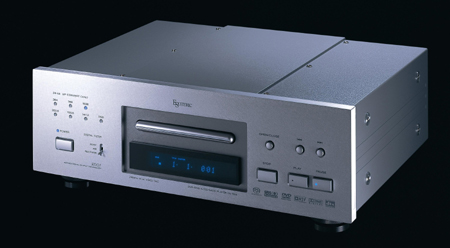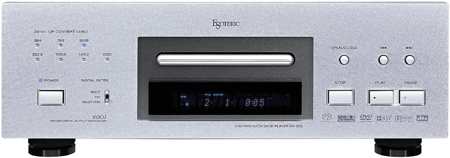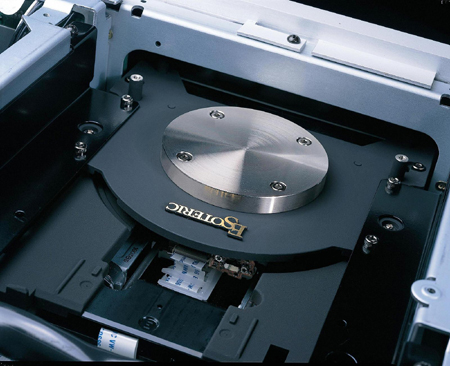You are reading the older HTML site
Positive Feedback ISSUE
16
november/december 2004
teac
Esoteric DV-50s universal player
as reviewed by Karl Lozier

KARL LOZIER'S SYSTEM
LOUDSPEAKERS
ELECTRONICS
SOURCES
CABLES
ACCESSORIES
|
Big. Bold. Beautiful. It sounds kind of corny, but those three words come reasonably close to describing this new version of Teac's Esoteric DV-50 universal player. Many audiophiles desire a player that will accept all of the currently available recording formats. Of course, we also wish that the player will sound good, as in really good. Many will also like to see (literally) that the player handles the movie formats. As you have probably already realized, demand has finally created supply.
Nearly the entire audio reviewing fraternity belatedly realized that most of those promising universal (or almost-universal) players had a very disturbing and unexpected flaw. Though many were based on a previous CD-only model, their Red Book CD playback quality seemed to have subtly deteriorated. TEAC's bold answer to that situation is their Esoteric line of players. Apparently, the company not only decided that CD playback quality would not be the DV-50s' weak point, but that it would be a strong point. In fact, both the Esoteric DV-50 and the new DV-50s offer two pairs of special outputs for two-channel CD and SACD playback. One special pair offers XLR outputs and the other offers RCAs. There are also two pairs of regular CD outputs, and the expected 5.1 outputs for surround sound, all of which are RCA connections. Next to the 5.l connections are a TosLink and a coaxial digital output plus a chassis ground post.
Because this is not a video magazine and I am not really a videophile, I will only briefly mention the video aspects of this product. The DV-50s offers one set of component conectors, two composite, and two S-video, plus a unique digital video output. Most of the differences between the DV-50 and the DV-50s are in fact in the video domain, and include replacing the original's 12-bit D/A converter with a new 14-bit design to keep up with the state of the art. The horizontal resolution claimed for this unit far exceeds 500 lines, greater than the resolution offered by typical DVDs. All I can say based on casual viewing is "Wow." Owners of the original DV-50 who wish to upgrade the video section can do so by contacting TEAC. The cost will be approximately the price difference between the two models.
I don't really care about remote controls, but many do. The DV-50s is such a high quality home theater device that it is a shame that some of the most frequently used controls are not lit. Also, there is so much unused surface area on the solidly built remote control that I wonder why the designers put the small buttons so close together. I can easily press four at one time. On the positive side, I should mention that when I used the remote control for track changing, the changes took place very rapidly and smoothly.

Nearly six and a half inches high and fourteen inches deep, the Esoteric DV-50s is bigger than most consumer players. Its goals are high, and the means to accomplish them, particularly for two-channel CD and SACD, are unique and rather complex in execution. The DV-50s' boldness is also apparent in its weight (almost 47 pounds) and impressive build quality, with very thick top and bottom plates that both shield the unit and help to quelch vibration. The form-follows-function esthetic is accentuated by the new, and very attractive, brushed aluminum finish. The just-arrived Herron VTSP-2 preamplifier, sporting a similar finish, made for a subtly stunning pairing, right down to the matching blue LED indicator lights.
This heavyweight player is supported by three "feet" that are actually spikes. At the other end of each spike is a round metal plate that can be covered by a supplied piece of protective felt. Spikes used as feet offer mechanical coupling, not isolation. These, plus the DV-50s' mass and thick chassis panels, follow the theory that mechanical coupling can lessen, transfer, or eliminate vibration in components. The basic idea is to transfer any vibration from the player elsewhere, and not vice-versa, but vibration and its treatment is a very complex subject. For example, a heavy component can actually store vibration and release it over time, giving it a greater negative effect.
Placing the component on a well-built platform, then isolating that platform with exacting care, can be even more effective, but there are two possible drawbacks. One is that this will raise the player's height by several inches, and the other is that many of the people willing to shell out six thousand dollars for a player will be reluctant to spend hundreds of dollars more on something that may not improve upon the intentions of the designers. I will experiment with this and report on my findings, but I am in no hurry since the DV-50s sounds so darned good as it comes from the factory. While audiophile tweaks like isolation platforms, power line conditioners, or exotic cables may improve the Esoteric DV-50s' performance, its fundamental sound quality will change relatively little. You can use it and enjoy it instead of futzing around with it, and for goodness sake, do not entertain even a fleeting thought of sending it somewhere for modification.

Of the power cords I tried, Kimber's top model, the Palladian PK-10, was the best of the bunch, and the only one that made an improvement in bass clarity and detail. It was closely followed by the top models of Purist Audio and Harmonic Technology. DiMarzio's and Harmonic Tech's top-of-the-line models were almost indistinguishable, and the obvious value choices. When it came to interconnects, Kimber's Select series of all-copper and all-silver cables reigned supreme, with the choice being between the richer and subtly sweet copper cables and the more incisive and minutely detailed all-silver ones. Suit yourself or your system, remembering the rather wide price difference. Kimber's Hero model was busy doing duty elsewhere in my systems, but I am guessing that it would have been a very good value choice in place of the all-copper Selects. The value-priced DiMarzio interconnects gave surprisingly fine sound, with a tonal balance similar to that of the silver Kimber Selects. As I write this paragraph, I am listening through the DiMarzio interconnects, and do not have any sense of audio deprivation. The Esoteric DV-50s does not have to be paired with exotic specialty cable to strut its stuff. Use what you have, or pick up one of the high-value cables I have mentioned. If you want to wring the nth degree of audio quality out of the DV-50s, try the Kimber Select cables or one of their expensive competitors.
The DV-50s has a simple and logically laid out front panel, but its exterior simplicity hides a wealth of complexity. It can be adjusted as desired by those who wish to take full advantage of its capabilities, or left alone by those who appreciate the set-it-and-forget-it philosophy. The central area of the front panel contains the drawer, which features a disc stabilizer that is one-third of an inch thick. Below that area, blue LEDs show all the usual information. The Esoteric accepted and played every disc I inserted. I'd imagine there are exceptions, but I did not encounter any.
Three round buttons on the right side are marked open/close, back, and forward. Below them are three larger rectangular buttons that control the stop, play, and pause functions. These are almost all that are really needed, with the exception of the on/off switch, another rectangular button on the bottom left. All the buttons act positively and with a solid directness. They are not of the silky type that makes you wonder whether the button has engaged the desired function. Next to the on/off button is the last control on the spartan front panel, a three-position vertical toggle switch, although if you are looking at a small or unclear picture, it will appear as if there were seven more very small buttons on the upper left. These are actually LED indicator lights. The function of the toggle switch and indicator lights is somewhat complicated, and must be described with a certain amount of detail. I will be brief enough to confuse many of you and elicit cries of dismay from those who are more digitally literate than I.
A bit of background is necessary. The Red Book (44.1 kHz) standard for CD playback was being called inadequate before any CDs were released. A major complaint was the extremely sharp, "brickwall" filtering that causes audible high-frequency distortions (i.e., digititis), though bass response was also affected, resulting in less fullness, richness, and natural "roundness." Solutions for the problem include upsampling and oversampling. They are not the same, but have similar results. I think of upsampling as changing to a specific higher frequency—from the standard 44.1 kHz to, say, 90 kHz. To change from the standard sampling frequency by doubling to 88.2 kHz or quadrupling to 176.4 kHz is oversampling. TEAC sidesteps the issue by using the term "Up Convert" to label the LEDs on the front panel. Upconverting or upsampling does not add any information. It simply allows for the use of other types of filtering (of higher frequencies) than that accomplished by brickwall filters.
Though all offer a slower rolloff and a sweeter-sounding high end response, the DV-50s' filters sound different—and are measurably different, particularly above 10 kHz or so—but forget about the underlying theories. Just experiment a bit with the three-position switch. You do not have to know what is really going on with the switch positions, as you cannot screw up anything. You will be doing things in the digital domain that no modifier or tweaker can do more than dream about. Remember, though, that the digital filter switch only affects the "special" pair of outlets on the back panel. I used only that pair for all of my listening, including the front channels for surround sound.
Actually there are only two filters, called RDOT and FIR. The third switch position combines the two, and supposedly offers the best characteristics of both. With a good sounding disc and a good audio system, each switch position will sound slightly different. Pick and choose when to use each. There is no right or wrong. If forced, I will admit to using the combined position far more often than either of the others Relying on the DV-50s' instruction manual, I will describe them, listing only the data for CD (44.1 kHz) use, although all inputs feeding into the special outputs will be affected.
RDOT: 705.6 kHz (16 times upconverting)
FIR: 352.8 kHz (8 times upconverting)
RDOT+FIR: 1411.2 kHz (32 times upconverting)
As you can see, that is very serious upconverting. The definitions and descriptions of the filters are as follows:
RDOT: A digital filter using Fluency theory. It has a slow rolloff and a natural, extended audio characteristic.
FIR: This filter has a sharp rolloff and firmly defined bass characteristics.
RDOT+FIR: The combination allows the best characteristics of both filters to be used.
DSD: Selected automatically with SACD playback.
I do a great many music reviews, and the companies that send me recordings expect me to be able to play them, no matter the format, so I have been rotating between three players. For two-channel and multi-channel SACD, I have relied on the Sony NS-999 ES, which has clean sound but lacks power and authority in the bottom two octaves, and has the same shortcomings with regular CDs. For DVD-Audio discs, my old standby has been the excellent though unheralded Toshiba SD-9200, which has a relaxed sound and a slightly distant perspective. For plain ol' CDs, I have been extremely pleased by the Cary 306/200 upsampling CD player, which includes decoding chips for the relatively few (but often truly outstanding) HDCD-encoded recordings.
That's enough background. It's time to pick up a disc—yes, any disc—and insert it into the Esoteric DV-50s and listen. Listening to regular CDs and using the special outputs on the DV-50s revealed outstanding audio performance, although there were no night-and-day differences between the Esoteric player and the Cary 306/200. Remember that I was comparing a $5000 CD-only player and a $6000 universal player (and one that was $5500 until the model change). I am not sure that the slight differences between the two players would be obvious in a showroom comparison. They included the DV50s' slightly darker background (better signal-to-noise ratio) and its very slightly more natural sound quality, characterized by a more rounded quality compared to the Cary's slightly etched and sometimes lean presentation. Again, these were minute differences. I do not think that most Cary owners would consider the DV-50s to be a significant upgrade for CD-only use, although Cary owners wishing for a comparable-sounding universal player have not had a single candidate until now, at least not in the sub-five-figure price category.
As for the needs and desires of our many other readers, I have good news, though the information will be relatively expensive if you buy the TEAC. I basically evaluated the DV-50s two times. I had almost finished my initial evaluation when I received Herron's ultimate tube preamplifier, the VTSP-2 (review to come) and rather quickly got hooked on its outstanding sound quality. After re-referencing myself by using it with the Cary player, I again compared the Esoteric to the Cary. I then had to re-evaluate the DV-50s on its own rather than directly comparing it with any other player. Here goes.
The DV-50s handled pop and jazz vocals (particularly female) with ease and without added harshness or edge. I used the player for my recent reviews (in PFO Issue 15) of the solo albums by Manhattan Transfer vocalists Janis Siegel and Cheryl Bentyne, as well as for a third album by the entire group. All three CDs are virtually flawless, and the DV-50s did nothing to mar them. The same goes for my long-time standard for male vocals, Frank Sinatra, as heard on "I Get a Kick Out Of You," recorded in 1962 and available on Sinatra: The Very Good Years (Reprise 26501-2). Make certain that the natural richness of his baritone voice is not bloated or exaggerated as he performs that lightly swinging arrangement by Neal Hefti. If his voice and enunciation do not sound supremely natural, as it did if you ever had the chance to hear him live, something is not quite right with your system.
I played my usual reference classical recordings, listening again and again to specific passages as well as the entire recordings. The first three-and-a-half minutes of the stupendous Reference Recording, Copland—100 (RR-93) has never sounded better in my home. About four years ago at CES in Las Vegas, it was the show-off recording in many rooms. The opening cymbal clashes and high-level unison trumpet playing are severe tests of an audio system. Previously, the best possible reproduction required a CD player with an HDCD decoding chip. The DV-50s' exemplary reproduction of this disc is evidently due to its unmatched upsampling abilities. It does not have HDCD decoding, and seems to have no need for it. I don't know if that flies in the face of theory or not.
I believe that the Esoteric DV-50s probably offers the best sound quality from CDs and SACDs of any less-than-ten-thousand-dollar universal player currently available. Do not be deterred by my matter-of-fact writing style. I rarely scrape the hyperbole barrel. I have not heard better SACD multi-channel or DVD-Audio in my home, though a couple of systems I heard at last year's CES may be stiff competition. I cannot imagine superior video reproduction, although that is not my area of expertise. During extensive listening sessions, it became apparent that the sound quality of certain CDs and the CD layers of hybrid discs, of the same recordings, are not of identical quality. Though it is still too early for even remotely final conclusions because of the scarcity of SACD and DVD-A versions of the same recordings, I believe that the quality of well-done DVD-A recordings is extremely difficult to surpass. I was able to compare two fun compilations entitled Dr. Chesky's Magnificent, Fabulous, Absurd & Insane Musical 5.1 Surround Show. One is SACD surround (SACD 273), and the other is DVD-Audio (and -Video) surround (CHDVD 272). The DVD-A version won the competition.
At this time, the Esoteric DV-50s remains in my home theater system. What I really need is one for each of my systems—in my dreams. Karl Lozier
DV-50s
Retail:
$6000
TEAC
web address:
www.teac.com
